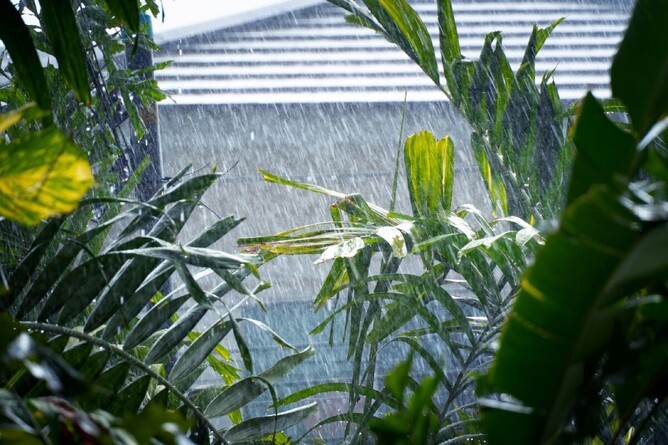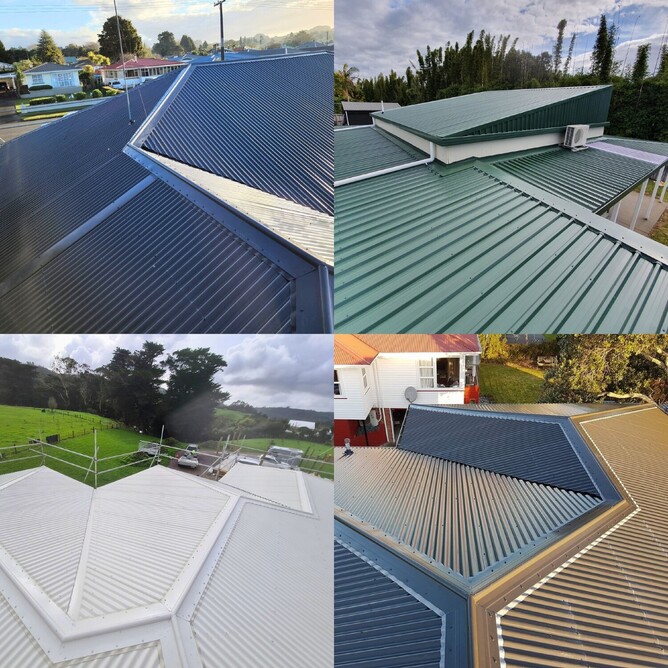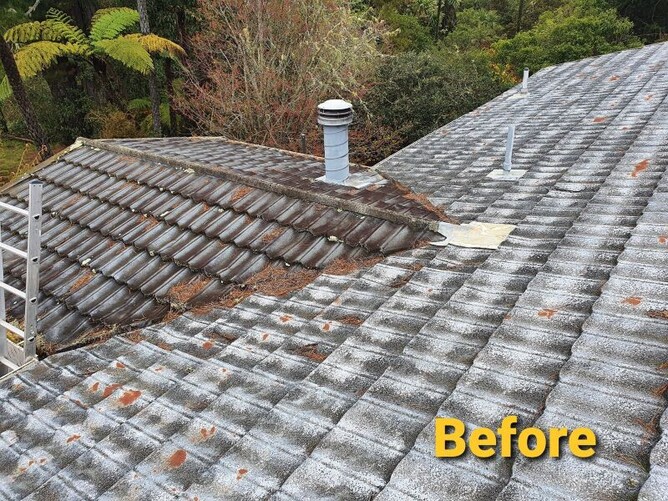When it comes to roofing in Kerikeri and across the Bay of Islands, from Kaikohe and Kawakawa to Paihia and Ōkaihau, your roof isn't just a shelter, it's your home's frontline defence against Northland's unique coastal conditions.
From humid summers and salty sea air to heavy rainfall and intense UV exposure, New Zealand's weather demands more from your roofing materials.
NZ Weather Challenges for Roofs in the Bay of Islands
In the Far North of New Zealand, particularly in coastal and inland towns like Kerikeri, Paihia, Kaikohe, and Kawakawa, roofing materials are put to the test year-round.
The climate in the Bay of Islands is subtropical and humid, and while it's a paradise to live in, the same can't always be said for roofing materials exposed to its extremes. For instance, the salt-laden coastal air can aggressively corrode metal roofing materials, leading to rusting and weakening of the structure.
Similarly, the high UV exposure can fade colours and degrade finishes, affecting the appearance and integrity of the roof coating over time.
Salt-Laden Coastal Air
One of the biggest challenges is salt-laden coastal air, which can aggressively corrode metal roofing materials if they aren't designed to handle it.
Homes closer to the ocean, like those in Paihia or near Ōpua, face higher levels of salt spray and moisture, which can lead to rusting, especially at roof edges and fastenings. Over time, this weakens the structure and compromises the look of the roof.
UV Exposure on Rooftops
UV exposure is another major factor. Northland experiences high levels of solar radiation throughout the year. The harsh sunlight can fade colours, degrade finishes, and accelerate the breakdown of inferior roofing materials.
This not only affects the appearance of your home but also the integrity of the roof coating over time
Prolonged Humidity and Heavy Rainfall
Heavy rainfall and prolonged humidity are also common, particularly in the summer months. Constantly damp conditions can encourage the growth of moss, mould, and lichen, particularly in areas where water pools or where tree cover reduces airflow.
Roofing systems must be able to drain effectively and resist moisture retention to prevent long-term issues.
Sudden Temperature Changes
Lastly, sudden temperature changes, especially between day and night, can lead to thermal expansion and contraction. If your roof isn't made from quality materials with strong structural integrity, these shifts can cause movement, cracking, or warping over time. It's especially important in elevated or open sites where wind and sun exposure are more intense.
That's why it's critical to choose roofing products engineered explicitly for New Zealand's coastal and subtropical conditions, like ColorCote®, COLORSTEEL MAXX® and and ARMORSTEEL COLORZEN®.
These brands have been tested in our unique climate and are trusted by roofing professionals like our team at Flood Roofing for their reliability, corrosion resistance, and long-term performance. They offer benefits such as marine-grade protection, high UV resistance, and toughness, making them ideal for the Bay of Islands.
Why We Recommend These Materials for Roofing in Kerikeri
COLORSTEEL MAXX® is designed specifically for New Zealand's harsher marine and coastal environments, exactly like those around Kerikeri, Kawakawa, and Ōkaihau.
Key Benefits of COLORSTEEL MAXX®:
Marine-grade protection: Specifically engineered to resist salt corrosion
High UV resistance: Maintains colour and finish longer under NZ's strong sun
Tough and long-lasting: Built to withstand high winds, rain, and coastal conditions
Backed by New Zealand Steel: Manufactured locally for local conditions
If you're anywhere near the coast or have experienced rusting or fading with older roofing, upgrading to COLORSTEEL MAXX® is a smart move.
ColorCote®: A Versatile, Durable Choice for Northland Roofs
Another standout performer we use is ColorCote®, which also offers a range of systems to suit different environmental zones, from inland farms to exposed coastal builds.
Why Choose ColorCote® Roofing?
Three levels of protection: Choose between ZinaCore™, MagnaFlow™, or Alumigard™ depending on your location
Great colour range: Match your home's aesthetic with a wide selection of NZ-inspired tones
Built for NZ conditions: Developed and tested here for real-world durability
Strong warranties: Confidence that your roof will last for decades
Whether you're building a new home in Kaikohe or reroofing a bach in Paihia, ColorCote® offers the right balance of resilience and visual appeal.
How Other Roofing Materials Compare in NZ's Coastal Climate
When choosing a roofing material for your home in Kerikeri or anywhere across the Bay of Islands, it's easy to be drawn in by traditional options like concrete tiles or long-run galvanised iron. While these materials do have their place, they often fall short when exposed to the unique environmental pressures of the Far North.
Concrete Roof Tiles
Concrete tile roofs, for example, are commonly used across New Zealand and are often chosen for their solid appearance and sound insulation properties. However, they come with some serious drawbacks in coastal or humid areas like Kaikohe or Kawakawa.
Concrete tiles are porous by nature, which means they can absorb and retain moisture, especially during long periods of rain or high humidity. This dampness can gradually seep into your roof structure, increasing the risk of mould growth, timber rot, and internal moisture problems.
Over time, the tiles themselves can become brittle and crack, especially in areas exposed to intense UV rays, making them vulnerable to leaks and water damage.
Another concern with concrete tiles is their weight. They're significantly heavier than metal roofing, placing more stress on the structural framing of your home.
This may not be a problem in brand-new builds, but for renovations or reroofing older homes in Paihia or Ōkaihau, it can lead to additional engineering costs or require strengthening work.
Regular Galvanised Corrugated Iron Roofs
Then there's traditional galvanised corrugated iron, which has been a staple in New Zealand roofing for generations. While it's more lightweight than tiles and has a familiar Kiwi look, galvanised iron lacks the protective coatings and advanced corrosion resistance of modern materials like COLORSTEEL MAXX®, ColorCote® or ARMORSTEEL COLORZEN®.
In salty coastal air, it can rust quickly, particularly at cut edges, fastenings, and joins, and its lifespan is significantly shorter unless it's meticulously maintained. Repainting or recoating is often needed far more frequently, which adds to long-term costs and upkeep.
Shingle Roofs
Some homeowners also look at asphalt shingles for a modern aesthetic, but these are better suited to dry, temperate climates.
In New Zealand's humid northern zones, they can deteriorate quickly, lifting or cracking under high UV exposure and heavy rain, and don't offer the same level of durability or warranty coverage as steel options.
By contrast, COLORSTEEL MAXX®, ColorCote® and ARMORSTEEL COLORZEN® roofing systems are specifically engineered for New Zealand's environmental extremes.
Their advanced coatings offer exceptional resistance to salt spray, UV rays, and moisture. They're also lightweight, easy to install, and backed by extended warranties, making them a far smarter choice for homes in the Far North.
Choosing the Right Roofing Material for Your Property
Every location across the Bay of Islands brings slightly different environmental challenges. Here's how we typically recommend roofing solutions based on location:
Kerikeri, Kaikohe, and Ōkaihau: Slightly inland, but still humid, ColorCote® ZinaCore™ or COLORSTEEL MAXX® perform well here
Kawakawa and Paihia: Coastal exposure means MagnaFlow™ or COLORSTEEL MAXX® is the best option for lasting protection
Elevated or exposed sites: We recommend the highest corrosion resistance systems, especially near the coast or on hilltops
Trust Flood Roofing for Expert Advice and Quality Installation
At Flood Roofing, we're not just installers, we're roofing specialists who know the Bay of Islands like the back of our hand. With our deep understanding of the local climate and our commitment to using only premium materials from trusted New Zealand brands like ColorCote®, COLORSTEEL MAXX® and ARMORSTEEL COLORZEN®, we install every roof as if it were our own.
If you're looking for expert advice on roofing in Kerikeri or anywhere across the Far North, talk to us first. Whether it's a new build, renovation, or a full reroof, we'll recommend the best product for your location and budget.
At The End Of The Day, Invest in Quality Roofing That's Made for Northland
When it comes to roofing in Kerikeri and across the Bay of Islands, cutting corners on materials may save a few dollars up front, but it can lead to costly problems down the track. Investing in premium New Zealand-made materials like COLORSTEEL MAXX®, ColorCote® and ARMORSTEEL COLORZEN® ensures your roof is built to last, handling everything the Far North throws at it and looking great while doing so.
That's why at Flood Roofing, we only work with premium New Zealand-made materials like COLORSTEEL MAXX®, ColorCote® and ARMORSTEEL COLORZEN® . These roofing systems are designed to handle everything the Far North throws at them, and they look great doing it.
Whether you're after a modern ColorCote® finish in Kaikohe or need a tough COLORSTEEL MAXX® roof for your coastal Paihia home, we've got the expertise to help you make the right choice.
With years of experience in the region and a solid reputation built on quality and service, we know what works, and what doesn't. So if you're planning a new build, reroof, or roof replacement in Kerikeri, Kawakawa, Ōkaihau or beyond, talk to our friendly team today. We'll guide you through the best product options for your location and ensure your roof is built to last.






